Windows 8 has been released to manufacturing on August 1st, meaning that all of the company’s hardware partners have had access to the final code of both Windows 8 and Windows RT for about two weeks now.
Since then, they have been hard at work with loading the new platform on their devices, while preparing for the big launch set for October 26th.
Although featuring a new interface and support for brand new features, Windows 8 is essentially similar to Windows 7 when it comes to loading it on new PCs.
On touchscreen-enabled tablets things might be a bit more difficult, but the real challenge comes from having Windows RT devices ready for launch.
Windows 8 is the first platform release from Microsoft to arrive on shelves with support for the ARM architecture, and opens the door to building a new ecosystem of applications.
Microsoft’s Mike Angiulo, vice president of Ecosystem and Planning team, notes in a recent blog post that a new era in ARM-based PCs is beginning with the launch of Windows RT, and he’s nowhere far from the truth.
The Redmond-based software giant has been working closely with its partners to ensure that all will be ready for the introduction of Windows RT devices and to ensure that users will have applications ready for them right from the start.
Some key points of these efforts include:
Windows RT shares significant code with Windows 8 and has been developed for and will be sold and supported as a part of the largest computing ecosystem in the world.
We have achieved our goal of one Windows binary for all Windows RT SoC platforms from NVIDIA, Qualcomm, and Texas Instruments, each of which has developed innovative ARM CPUs that form the basis of a complete system.
Delivering Windows RT PCs has been about building out a new system for the first time—a completely new ecosystem of PCs providing opportunities for PC makers to bring to life a new generation of PCs with new capabilities, starting with ARM-based processors.
Windows RT PCs are thin and light in industrial design, and have long battery life and integrated quality. These PCs have all been designed and manufactured expressly for Windows RT.
PC makers will provide Windows RT PCs as integrated, end-to-end products that include hardware, firmware, and Windows RT software. Windows RT software will not be sold or distributed independent of a new Windows RT PC, just as you would expect from a consumer electronics device that relies on unique and integrated pairings of hardware and software. Over the useful lifetime of the PC, the provided software will be serviced and improved.
Microsoft will be one of the companies set to launch devices based on Windows RT this fall, but it won’t be the only one. In addition to its Surface tablet, we should see Windows-based ARM tablets coming from Asus, Dell, Lenovo, and Samsung as well, the software giant notes.
At the same time, the company notes that Windows RT PCs are not restricted to the slate form factor, and that some of them will also land on shelves with full keyboard and touchpad solutions.
They will include Windows 8-optimized touchpads, with new firmware to fit the features that the platform comes with, along with other hardware specifically designed for the upcoming operating system.

 14 DAY TRIAL //
14 DAY TRIAL //